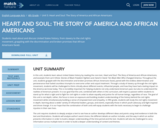
English Instructional Plan – Analyzing Word Choice in Paired Texts
- Subject:
- English
- Reading
- Material Type:
- Lesson Plan
- Author:
- VDOE Project Team
- Date Added:
- 04/14/2022

English Instructional Plan – Analyzing Word Choice in Paired Texts

English Instructional Plan – Analyzing Word Choice in Paired Texts

English Instructional Plan – Analyzing Word Choice in Paired Texts

In this unit, students learn about United States history by reading the core text, Heart and Soul: The Story of America and African-Americans, and excerpts from Let It Shine: Stories of Black Freedom Fighters and Hand in Hand: Ten Black Men Who Changed America. Throughout the unit, students grapple with the discrimination and broken promises African Americans faced, paired with the endless determination and perseverance that fueled countless triumphs to overcome unfair and unjust treatment. Through a study of slavery up through the civil rights movement, students will be challenged to think critically about different events, influential people, and how they have had a lasting impact on the America we know today. This is incredibly important for helping students not only understand America's past, but also to understand the realities of America's present. It is our goal that this unit, combined with others in the curriculum, will inspire a passion within students to stand up for what is right and to fight for civil rights in order to attain equality and justice for all human beings, regardless of race. The goal of this unit is not depth; rather, the focus is more on exposure and building student understanding of the history behind the civil rights movement while simultaneously building a sense of empowerment and empathy. In fifth grade, students will study the civil rights movement in depth, learning about a wider variety of influential leaders, groups, and events, especially those in which youth advocacy and fight inspired and drove change. It is our hope that the combination of both units will equip students with the tools necessary to begin to challenge injustice in their own lives.
The unit requires students to deeply analyze a text to see how an author develops different ideas and points using vivid evidence in both the text and illustrations. Students will analyze author's word choice, the different details an author includes, and the way in which an author presents information in order to build a deeper understanding of the time period and the text. Students will also be challenged to carry information across multiple texts in order to build a deeper understanding of content and themes.

In this lesson, the art of blackout poetry is used to demonstrate how word choice estabishes an author's tone. Blackout poetry is a creative way for students to take a selected work and change the tone by selecting and pulling specific words from the text. Students see how choosing words and manipulating text impacts the tone and can change the meaning of a text.

In this unit students will explore the difficulties of having a learning disability and how a learning disability influences the way a person feels about themselves by reading the core text, The Wild Book. Throughout the unit students will be challenged to think about multiple thematic topics—believing in ourselves, accepting differences, persevering through challenges, and trusting in family during difficult times. Exploring the themes will allow students to develop a deeper appreciation for people's unique differences and struggles and learn to accept everyone for their strengths. It is our goal that this unit, combined with others in the curriculum, will help students see the world as a diverse place, not just in terms of race but also in terms of abilities, and that no matter what, everyone can be successful.
The text, The Wild Book, was chosen not only for its powerful themes but because Margarita Engle, the award-winning Latina author, uses verse to bring to life a difficult historical period in Cuba. The book tells the story of Margarita Engle's grandmother who grew up in Cuba during a time of lawlessness. Margarita Engle tells her grandmother's story in a way that helps readers build empathy and understanding of the hardships our ancestors may have faced. Simultaneously, students also see the power of poetry and its influence on Cuban culture in the early 20th century. Seeing that despite the hardships the country faced, it was also a place of artistic beauty.
This unit builds on previous units in which students have learned the features of poetry; however, in this unit students begin to see poetry as not just stand-alone poems but as an art form in which a poet can express himself or herself freely. When discussing and writing about poetry, students should be able to refer to the specific structural elements of a poem and explain how the elements enrich the text. This unit also challenges students to deeply analyze how authors develop theme within individual poems and also across a longer work. Students will analyze how characters are developed, how word choice and imagery are used to bring power and meaning to different verse, and how the author uses varying experiences to reveal theme. Doing deep text analysis of the poems on an individual level and also on a more broad level will help students understand the power of the various themes and how the author develops them.